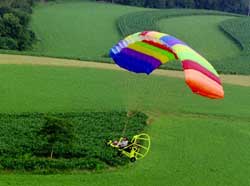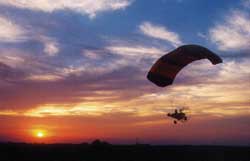|
|
 |
| SW Aviator Magazine is available in print free at FBOs and aviation-related businesses throughout the Southwest or by subscription. |

|
 |

|
 |
 |
 |
|
The web's most comprehensive database of Southwest area aviation events.
|

|
 |

|
 |
|
Featured Site:
|
|
|
 |
|
A continuosly changing collection of links to our favorite aviation related web sites.
|

|
 |

|
 |
 |
|

|
An Unusual Flying Machine
|
|
|
|
Powered Parachutes
|
By Carolyn Kennedy
Photos by Russ Marsolek
I have flown a kite; I have flown in a 747; I have been a passenger in a glider plane; and I have been parasailing over the bay at Acapulco. None of these experiences came close to matching the thrill of powered parachuting. The “flying lawn mower,” or powered parachute, is a recent invention to get man off terra firma but not necessarily into the clouds. Flying at approximately 600 feet, the contraption offers an alternative to larger, more complicated, more expensive flying machines.
Last December my son called to tell me that he had taken a ride in a powered parachute. He sent pictures. To call this odd configuration an airplane is a stretch. On the ground, it looks like a go-cart with a colorful canopy trailing it. Referred to as a PPC, it is lifted by flexible wings—the nylon parachute. The frame supports the pilot, the engine, and the propeller. It sits on three wheels and the design is triangular. My son fell in love with the sport and soon bought his own PPC. With ownership came the requisite accouterments: a trailer, a ground-to-air radio, gas cans, lots of bungee cords, and of course, a leather jacket. Then there were the lessons. After obtaining a certificate allowing him to occupy the air space that “real” airplanes don’t use, he took more lessons to be an instructor. The plane he bought is a two-seater designed for training someone else to fly.
On a calm, sunny day-after-Christmas, we met him at a tiny airport in Smithville, Texas. He and about 15 others were staging a fly-in. My son lives in Dallas, where he was a practicing emergency physician. He met his friends from the Houston area in this central Texas location because he didn’t know anyone in Dallas who flew. We gathered at the Smithville Airport, a location for small private craft and ultralight planes. The PPCs travel on the ground and in the air at approximately 25 mph. They get to this speed across a runway or on a field. Then the parachute fills and the machine is lifted upward, slowly gaining altitude. That windless day, my son took his up to 1100 feet, but that is unusual. The normal sightseeing loft is about 600 feet. Landing is a bit trickier, but not too difficult. With pedals one maneuvers the cables that connect the parachute to the rudder, and throttles down or even turns the engine off completely. As it approaches the earth, the machine levels off, the parachute drags the air, and the craft lands, rolling several yards to a stop.

I won’t go into the intricacies of the mechanism, as I don’t pretend to understand them. I see the pilots unfurl the parachutes very carefully on the ground, checking the lines that connect it to be sure they are not tangled. They check the oil and fuel levels. They check the radio. After completing his checklist, the pilot is ready to fly. He makes sure that no other craft is near, and he begins the take-off. His buddy on the ground keeps him advised of anything that he possibly can’t see: high wires, incoming aircraft, and other parachutes taking off or landing. The buddy performs the same duties as the pilot makes preparations to land.
I had to try it. An experienced pilot offered to take me up. Sitting harnessed behind him, I listened in excited anticipation while Phil explained to me that I could hear him and speak to him through the head set that I wore. Up we went—only to about 300 feet. Flying in the powered parachute is an out-of-body experience. I looked down on the hay field from which we took off as we climbed above the earth, and I wondered if this is how angels feel. When I let go the white-knuckle grasp I had while rising, I pulled out my camera and took some pictures. The motor noise was a bit much at full throttle, but then Phil throttled down and we soared peacefully over streams, grazing cattle, and farmers on tractors. The experience was uplifting—I felt at one with the universe. That sounds like poetic license (or bullshit), but I honestly felt as if man were meant to fly. Turning was a challenge to my faith in this machine and in flying per se. As the craft leaned one way or the other, I clutched the pilot’s waist, an unnecessary and unhelpful precaution. Soon I got the rhythm and felt trust come flooding back. After about fifteen minutes of fun, the pilot asked me if I were ready to go down. I could have stayed up for hours, but I wanted to be respectful of his time and fuel, so I agreed and we started our descent. I white-knuckled again until I got the hang of pointing slightly downward. Then I relaxed as we connected with ground and rolled to a gentle halt. Such exhilaration; such excitement! I can’t wait to go again.
One of the restrictions of flying a powered parachute is the velocity of the wind. Living in West Texas I probably will not purchase a plane, as there are too many days when the wind exceeds the limit—six miles per hour. But in other parts of Texas, there are many flying days. When the wind gets up, the pilot goes down. Safety is a prime consideration among my son’s group of friends.
Because the sport is not highly regulated, it is incumbent upon the pilots to make their own rules and stick to them. My son is very prudent, for which I am extremely thankful. He has prepared a thorough pre-flight checklist and offered it to others. He refuses to fly too near to dark or if wind conditions are risky. He carries extra fuel and motor oil in his trailer. He has learned basic maintenance and takes care of problems when they arise. Without such vigilance, the sport can be fraught with accidents. A friend carried his “stuff” in a small gym bag. Forgetting to tie it down, he was flying when the bag took off and got caught in the propeller, causing a crash. The only damage was to the machine, but that was costly. The old “stitch in time” precept works wonders in assuring a safe and enjoyable flight.

In the year since my son took up the sport of flying a PPC, he has quit his job practicing medicine in Dallas. He travels whenever and wherever he finds people gathering to fly. Pulling his machine in his enclosed trailer, he finds small airports or level grassy fields whose farmers grant permission to take off and land. Observers are fascinated. They want to watch, touch, and talk about it. They want to go for a ride. The sport is growing in popularity. The cost of purchasing a PPC is approximately $20,000 new and as little as $10,000 used. Many people build their own. Both the daring and the cautious find thrills in maneuvering the craft. Look up. You may see what appears to be “Chitty Chitty Bang Bang” flying over your head. Please smile and wave. If the pilot is my son, you could offer him a job.
|
Click here to return to the beginning of this article.  |
|